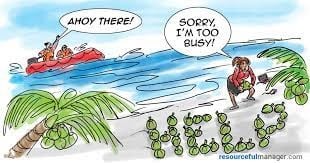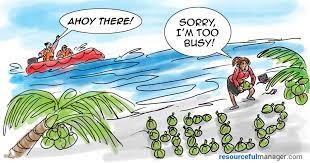Too busy for good decisions?


Burning through labor, fighting fires
Tell me if you’ve seen this advertisement before - a manager seamlessly switching between her tablet, mobile phone, laptop; pulling up data effortlessly, shooting off an email with a satisfied “mission accomplished” smile, then sitting back and sipping her coffee as she looks off the deck of her lakefront cabin?
Of course you have. This is the promise that technology companies have been selling us for years. Beautiful technology products integrated with all the information we need, saving us time during the workday that we can repurpose for mindful reflection or cooking in some Nancy Meyers inspired kitchen.
But what’s the reality? An overworked manager, running from meeting to meeting (or Zoom to Zoom), putting out fires, wrangling information from multiple departments to make decisions they hope work out, and if they don’t, they can look forward to putting out those decision related fires the next day.
What is more, is that unfortunately that reality may only become more commonplace as the world only gets more complex. Managers will be forced to make more decisions, faster. Marketing is becoming more nuanced and targeted, sales professionals will sell to more informed customers, supply chains will continue to evolve to be nimbler. Further complicating our day-to-day life will be the need to make these decisions remotely, fighting through botchy internet connections as we interact digitally.
In a recent Columbia University study, managers make on average 70 decisions a day, as an organization that number goes up to the tens, even hundreds of thousands. Seems like were adopting to the complexity and being productive, right? The data tells a different story. In a 2019 McKinsey study, “Decision making in the age of urgency”, 68% of middle managers reported that their decision-making time was spent inefficiently. Additionally, across three decision types which they define as “big bet”, “Cross-cutting” and “Delegated”, managers believe only 57% are of high quality (done well).
The “so what” of it all? Managers are saying they spend much of their decision time poorly, and worse - making bad decisions in the process. This has a real cost. The McKinsey researchers calculated that for the average Fortune 500 company, this translates to 530,000 days of lost working time, or $250MM in wasted labor costs per year.
While technology might not have been the answer to reclaiming our precious time, perhaps a better decision-making process is?
In our work with clients, we found a couple of key drivers that lead managers to spend their decision making time ineffectively.
Reinventing the wheel
First, they continuously recreate the wheel. Working with a recent consumer goods client, we interviewed three different brand managers on how they make the decision to change price. What we found is each brand manager identified significantly different factors that drive their decision making – some stated impact on volume and margin as a top priority, while others stated channel-partner and competitive reaction as top priority. Given the brands shared a similar consumer base and unified corporate strategy and objectives you would expect a more similar approach. What was more troubling was within the same brand, brand managers approached the same decision using different factors over time – an inconsistent approach to the same decisions. Why? Because every time they approached the decision, they recreated their decision framework. Even worse, often they just started reviewing whatever data was immediately available to make what was ultimately, just a gut decision.
Prior to making these decisions, managers should first create a plan. This can be done via a framework, or checklist for the decision. Thinking about the decision to be made, creating a tree or checklist of sub-questions that need to be addressed to make this decision. They should ensure that the sub-questions cover the spectrum of considerations and get buy-in of those questions from various stakeholders before even starting the decision process.

My esteemed colleague and decision expert, Erik Larson, Co-Founder and Chief Product Officer at Cloverpop, conducted a three month study of 100 managers. His research found that “businesses using this checklist (or framework) make 75% better decisions, twice as fast with half as many meetings and 20% better performance”. You can read more in his Harvard Business Review article titled, A Checklist for Making Faster, Better Decisions.
Boiling the ocean:
Let’s take a trip back to 2002, specifically, to Tom Cruise’s film, Minority Report. In the movie, Tom Cruise navigates a multi-touch screen, showing a birds eye view of all the crime occurring (or will occur – great foresight ). He had the ability to zoom into specific situations to stop them before they come to fruition. IT vendors have promised us a similar interactive bird’s-eye view of our own business. A “single source of truth” for all decision makers to orient themselves and make calls on the same set of data.
To bring this to fruition, we built “Data Lakes”, bringing together massive stores of data. To make use of this information, we’ve built libraries upon libraries of dashboards for managers to access the information. While these capabilities have opened doors to better insights and information, they have also overloaded decision makers with information – driving them to drop the data and use their intuition. Contradicting research, broken dashboards, subscription fatigue have all contributed to this.
So what can we do? IT, Research, Analytics and other “decision facilitator” functions can help their over-data-stimulated counterparts here. At Cloverpop we work with these functions to map out decision tree’s (ex. Should we change price) and align decision sub-questions (ex. What will be the impact on volume?) to specific data sources (ex. Price elasticity model). We then bring all those data sources into one place. This way, once the decision maker needs to make a decision, they are able to connect questions they need to answer, with the data they need, all in one place. We call these “Decision Playbooks”, a simplified view can be found in figure 1.

Not only does this approach help decision makers get more organized, It’s also a cost saving opportunity for organizations. One client, a consumer software developer, was trying to make the most of their data. An internal study had shown (I mask the actual numbers for client confidentiality, but they are in range) that out of nearly 10,000 dashboard views created, only about 10% where used on a monthly basis and >50% hadn’t had a single view in 90 days. We worked with the client to develop these decision playbooks, and any dashboard view and/or data source that didn’t connect to a decision to be made, they got rid of. Data, information is only valuable if it helps you decide and act, otherwise there is no value. If your data doesn’t connect directly to a decision – GET RID OF IT, SAVE YOUR TIME, SAVE YOUR MONEY.
Conclusion:
Fundamentally, I’m advocating for organizations to step back and take a more process-oriented approach to planning their decisions. While stage-gates, sign-offs and meetings act as a check, they do not improve speed or quality of decisions. The upfront planning phase of a decision has profound downstream benefits to the quality of the decisions outcomes. What is more, is that upfront planning, though it takes some time, pays off in multiples in time saved for managers. How much should companies invest in better decision processes – well, how much would you invest to reclaim $250MM in lost labor?
